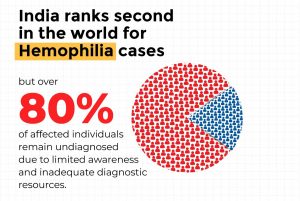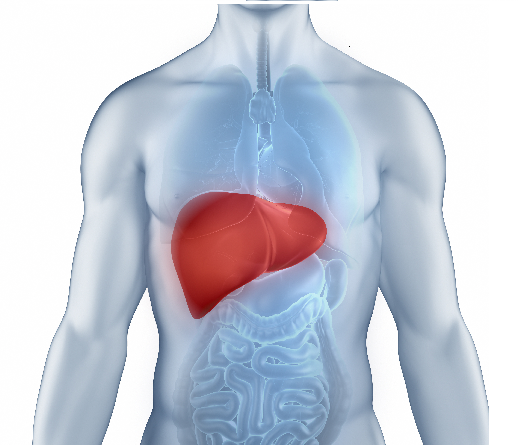Hemophilia – Causes, Symptoms and Treatment
- 17 Apr, 2023
- Written by Team Dr Lal PathLabs
Medically Approved by Dr. Seema
Table of Contents
What is Hemophilia?
Hemophilia is a rare genetic disorder that affects the blood’s ability to clot properly, leading to excessive bleeding and bruising. The disorder is caused by a deficiency or absence of certain clotting factors in the blood, which are necessary for the blood to clot. Hemophilia is a chronic condition that can be managed with proper treatment and care.

What Causes Hemophilia?
Hemophilia is caused by a deficiency or absence of certain clotting factors in the blood. The two most common types of haemophilia are Hemophilia A and Hemophilia B, which are caused by a deficiency of clotting factor VIII and clotting factor IX, respectively. Hemophilia is a genetic disorder that is passed down from parents to their children through the X chromosome. The X chromosome carries the genes that produce clotting factors VIII and IX, and males inherit one X chromosome from their mother and one Y chromosome from their father. If a mother is a carrier of the defective gene that causes haemophilia, there is a 50% chance that her son will have haemophilia.
What are the symptoms of Hemophilia?
The most common symptoms of haemophilia are excessive bleeding and bruising.
- People with haemophilia may experience bleeding episodes that can last for a long time or may bleed spontaneously without any injury or trauma.
- Bleeding can occur internally, in the joints, muscles, and organs, or externally, from cuts or wounds.
Common symptoms of haemophilia include joint pain, stiffness, swelling, and limited range of motion, especially in the ankles, knees, and elbows. Hemophilia can also cause bleeding in the brain, which can be life-threatening if not treated promptly.
What are Hemophilia Types?
There are four main types of haemophilia: Hemophilia A and Hemophilia B, Hemophilia C and Acquired Hemophilia. The hemophilia types are classified based on which clotting factor is deficient in the blood.
- Hemophilia A: Hemophilia A is the most common type of hemophilia, accounting for about 80% of all cases. It is caused by a deficiency of clotting factor VIII, which is necessary for the blood to form clots. Classic hemophilia is another name for hemophilia A.
- Hemophilia B: Hemophilia B is also known as Christmas disease, named after the first patient diagnosed with the condition. It is caused by a deficiency of clotting factor IX, which is also necessary for the blood to form clots. Hemophilia B is less common than Hemophilia A, accounting for about 20% of all cases.
- Hemophilia C: Factor XI deficiency, which is also referred to as Hemophilia C, is a relatively uncommon form of hemophilia that impacts approximately one in every 100,000 individuals.
- Acquired Hemophilia: A rare condition where the body’s immune system mistakenly attacks a protein called factor VIII that helps the blood to clot, leading to uncontrolled bleeding.
Both Hemophilia A and Hemophilia B are inherited genetic disorders that are passed down from parents to their children through the X chromosome. Males are more likely to be affected by haemophilia because they only have one X chromosome, while females have two X chromosomes. If a female inherits a defective X chromosome from one parent, the normal X chromosome from the other parent can compensate for the deficiency, and she may not have symptoms of haemophilia. However, females can still be carriers of the defective gene and pass it on to their children.
Diagnosis of Hemophilia
Diagnosing haemophilia involves a series of tests to measure the levels of clotting factors in the blood and to identify any abnormalities in the clotting process. The diagnostic process usually involves the following steps:
- Medical history: The doctor will ask about the patient’s medical history, including any family history of haemophilia or bleeding disorders.
- Physical examination: The doctor will examine the patient for signs of bleeding, such as bruising, joint pain, or swollen joints.
- Blood tests: Blood tests will be performed to measure the levels of clotting factors in the blood. A complete blood count (CBC) will also be done to check for any abnormalities in the blood cells.
- Clotting tests: Specialized tests will be done to measure the time it takes for blood to clot. The most common tests are the activated partial thromboplastin time (aPTT) and the prothrombin time (PT).
- Genetic testing: Genetic testing can confirm a diagnosis of haemophilia and determine the specific type of haemophilia.
- Joint X-rays: X-rays may be taken of the joints to check for any damage caused by bleeding.
If haemophilia is diagnosed, further tests may be done to determine the severity of the condition and to develop an appropriate treatment plan. Hemophilia is usually classified as mild, moderate, or severe based on the level of clotting factor in the blood. Severe hemophilia is defined as having less than 1% of the normal level of clotting factor, while mild hemophilia is defined as having between 5% and 50% of the normal level.

How is Hemophilia Treated?
Hemophilia is a chronic condition that requires lifelong treatment and management. The goal of treatment is to prevent bleeding episodes and manage bleeding when it occurs. The primary treatment for hemophilia is replacement therapy, which involves infusing the missing clotting factors into the bloodstream to promote clotting. Clotting factors can be obtained from donated blood, plasma, or recombinant technology. Hemophilia patients may require regular infusions of clotting factors on a prophylactic basis to prevent bleeding episodes or on-demand basis to treat bleeding when it occurs.
Other treatments for hemophilia include desmopressin (DDAVP), which can stimulate the release of clotting factors in mild hemophilia A, and antifibrinolytic agents, which can help prevent the breakdown of blood clots. In some cases, hemophilia patients may require surgery to repair or replace damaged joints or to remove internal bleeding.
How is Hemophilia Prevented?
Since hemophilia is a genetic disorder, it cannot be prevented entirely. However, genetic counselling and prenatal testing can help identify carriers of the defective gene and reduce the risk of passing it on to their children. Hemophilia patients should avoid activities that can cause injury or trauma and take precautions to prevent bleeding, such as wearing protective gear and avoiding medications that can interfere with clotting.
In conclusion, hemophilia is a rare genetic disorder that affects the blood’s ability to clot properly, leading to excessive bleeding and bruising. The disorder is caused by a deficiency or absence of certain clotting factors in the blood, which are necessary for the blood to clot. Hemophilia can be managed with proper treatment and care, including replacement therapy, desmopressin, and antifibrinolytic agents. Hemophilia patients should also take precautions to prevent bleeding and avoid activities that can cause injury or trauma.














